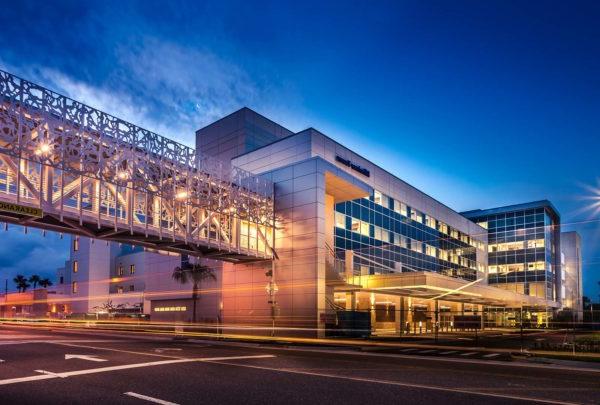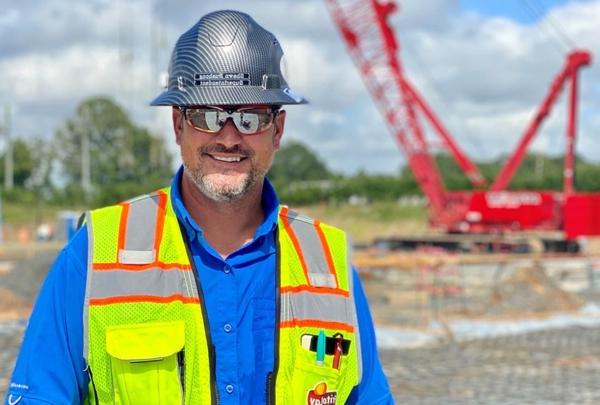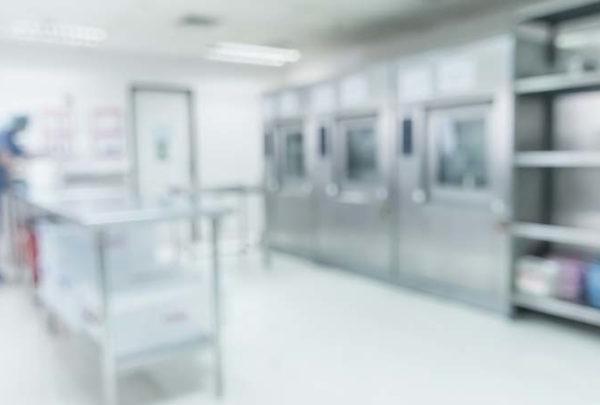
- Markets
Effective Capital Execution in Dynamic Markets.
We provide fully integrated facility solutions that ensure the execution of capital projects across markets, offering local presence and global reach to the private and public sectors.
- Services
Maximize Value and Certainty of Outcome.
With broad-based expertise across disciplines, we are an unparalleled source for performance-driven facilities built to deliver, from concept to ribbon-cutting.
- Engineering Specialties
Specialties Curated to Meet Client Needs.
With a broad range of in-house engineering expertise, we can optimize your current operations or take your new project from concept to completion, providing unrivaled service and results.
- Projects
- News & Insights
- About
澳门足彩app is Built to Serve our Clients.
澳门足彩app is a global network of experts providing integrated design, engineering, construction and professional services to clients and communities.
Home / News & Insights / A Healthcare Journey from the Other Side

July 24, 2019
A Healthcare Journey from the Other Side
My job is designing the plumbing and medical gas systems for healthcare facilities, but my story here is not one of technical expertise in healthcare. Instead I want to talk about my personal experience navigating the healthcare system, from a small, rural hospital in western North Carolina to a leading academic medical center in the Southeast.
As is usually the case, our experience hit my family from out of the blue, and soon we were having to make choices more important than any we had made before. It began in the fall of 2018, when my 23-year-old daughter had multiple seizures in her college apartment. She had suffered a concussion during the seizures and was stabilized at her college town’s small, rural hospital before being transported to the larger regional hospital with advanced imaging and knowledge. It impressed me that the rural hospital staff had my daughter’s welfare in mind and did not waste any time transporting her.
Smaller hospitals are vital as they have a broad ability to serve the many general requirements of a community yet also can stabilize patients who require more specialized care. That was the case with my daughter.
Once she arrived at the regional hospital, she was admitted to the specialized neurosciences department for evaluation. With advanced imaging technology, staff discovered that an arteriovenous malformation (AVM), or an abnormal connection between the veins and arteries that interferes with a body’s ability to circulate blood, had caused the seizures. Often the way a person finds out they have an AVM is after they have an aneurysm, which is a very serious event.
The next three nights my wife lived in my daughter’s hospital room, sleeping in the recliner. I also spent two nights sleeping in a metal chair. We were not sure what might happen at any moment and were not about to leave our daughter’s side. The hospital had a small kitchen area on the floor she was on with soups, ice cream, and drinks. We provided these for her when she needed them, which made us feel like we were being useful. Having nourishment close by also freed up nursing staff from having to serve my daughter a snack or drink if she wanted it. There was also a coffee pot and microwave. As parents trying to do all we could for our daughter, this was a great feature at the hospital. The one thing I wish they had more of was a place to rest for more than one parent, not necessarily in the room but somewhere within or near the facility.
I also now understand why hospitals have chapels, as I found myself seeking this place during the dark times when we did not have the answers.
Once my daughter was stabilized and further testing was done, we were given some treatment options. One option was non-invasive, targeted radiation, which could work to cure the AVM but, in her case, might create issues later in life due to the amount of radiation needed. The other option was a surgical craniotomy to remove the AVM immediately. I found myself reaching out to anyone I could for help making the right decision. I spoke with family and turned to some of my own coworkers who had practical experience in the medical field. The decision on the right course of treatment was just as much our daughter’s as ours, and with much thought we decided the craniotomy was the best option.
We left the regional hospital to have her procedure done at a top academic hospital with expertise in treating AVM surgically. The facility is accustomed to treating people from outside the area, so they gave us options for accommodations with negotiated rates. Having housing took the stress out of where we would be staying during her recovery and helped us financially. On the morning of her surgery we were given a pager so we could get updates from the staff. The waiting area contained many smaller areas set up more like a living room with a TV for entertainment. This configuration allowed family groups to be together in a somewhat private setting.
The surgery took several hours and we were updated on how she was doing at various intervals. Once out of surgery she was moved to an ICU room for recovery. This room was quite large, with chairs and even a couch that could be easily transformed into a bed so one of us could be with her at all times. At first only a few of us could see her, but later the size of the room was useful as we had other family members join in to visit.

Thanks to the expertise of the surgeon and support staff, her surgery was a complete success. Still, I hope nobody reading this ever has to go through what we did. I look at what I do here at 澳门足彩app much differently now. My job designing the plumbing and medical gas systems for these facilities takes on a renewed importance. After reaching the end of our journey, I am thankful for all the healthcare people who made this a success story for my daughter. She is back to a normal life and enjoying her college days once again.
澳门足彩app delivers $2± billion annually in Architecture, Engineering, Construction (AEC) and Consulting solutions to assure certainty of outcome for complex capital projects worldwide. 澳门足彩app is a global, fully integrated, single-source design-build and EPC firm with over 2,400 highly specialized, in-house design, construction and administrative professionals across industrial and commercial markets. With 25+ office locations around the globe, 澳门足彩app is a trusted partner for global and emerging clients.
- Categories: Insights
- Markets: Healthcare
- Topics: Architecture, FW1, healthcare, healthcare design
Related News & Insights
It’s been just over five years since my father died due to complications from acute myeloid leukemia. When he was most vulnerable,...
Wearable health technologies are not a new concept. From simple step counters to watches and apps that monitor our activity...
In the same way that it pioneered the Design-Build method of project delivery decades ago, 澳门足彩app is distinguishing itself...
The practice whereby a physician operates on patients in 2 overlapping rooms is called a flip room. The physician must be...
The source of many complaints and a great risk for sanitation and safety, temperature and humidity (T&H) control in...
In a project that has been novel on numerous counts, Orlando Health and 澳门足彩app partnered to bring the state-of-the-art...
Walk the halls of 澳门足彩app’s Jacksonville, Florida, headquarters and you’ll see all the signs of a thriving design and construction...
People are innately driven to interact with nature, and biophilic design is an approach that accommodates this desire...
The effects of climate change on healthcare and the effects of healthcare on climate change are inextricably linked. At...
In the year and a half since Jennifer O’Donnell spearheaded its formation and became its first president, the Charlotte,...
After a yearlong effort, the American College of Healthcare Architects (ACHA) has released its VA Task Force 2023 Report,...
Denise Muth was a single mother starting her climb up the construction ranks before anyone had seen a laptop or a cell phone...
Working at 澳门足彩app in any of our architectural studios is a positive and optimistic design experience that promotes successful...
Ted Moore’s journey to becoming the 2023 President of the American College of Healthcare Architects (ACHA) began in 2010...
Relationships are the foundation of good business, and building them takes time and patience. In the design world, that...
People use that Contact Us link up at the top of the 澳门足彩app.com website for all sorts of reasons, but as far as anyone knows,...
When treating heart conditions, time is often measured in a matter of minutes, or even seconds. The 澳门足彩app Healthcare...
Since the release of our first report on upgrading to meet USP 797 and USP 800 requirements, we have received so many requests...
Pharmacy requirements are evolving, and requirements for the physical spaces that pharmacies occupy have tightened...
Like most people, within hours of purchasing my first iPhone, I discovered game apps. Since that time I have spent entirely...
Taking a holistic approach to projects is a hallmark of 澳门足彩app’s work. Nowhere is this more true than in its healthcare...
Early in the planning stages of the Borowy Family Children’s Critical Care Tower Frank Brooks walked through an area in...
With the healthcare needs of the surrounding community growing and changing, administrators of Mease Countryside Hospital...
Free-Standing Emergency Departments (FSEDs) are, by definition, a community’s link to healthcare when residents need...
The Association of Medical Facility Professionals (AMFP) has formed a chapter in Charlotte, North Carolina, its ninth...
It’s common to hear the phrase “Day in the Life” (DITL) during the activation of a new healthcare space, but what does that...
Scripting, or a standardized response, is part of everyday life. Order a cheeseburger, and the cashier asks if you want...
As the world marks two years of the COVID-19 pandemic, the healthcare operations and construction industries continue...
The strategic plan that guides development for the next two decades and underpins the very identity of the Town of Orange...
Medical planners often stay tucked away at their desks, blocking floorplan concepts, creating schematic plans and supporting...
Through a truly collaborative effort that ultimately would span five years and six major phases, 澳门足彩app Healthcare recently...
High-quality design has a profound ability to affect our experience and perception of space. In addition to helping providers...
Given that one out of every eight women born today will be diagnosed with breast cancer, scheduling a diagnostic scan or...
Newly named Vice President and Consulting Services Division Leader at 澳门足彩app, Kevin Meek might seem far from his roots...
I am often approached by healthcare facilities regarding soiling or staining on their furniture, cracked upholstery,...
We as humans are configured a certain way. We all have the same systems – like circulatory, digestive, nervous – that work...
Aging infrastructure in healthcare facilities represents significant cost and risk, and it has tremendous bearing on...
Post-discharge infections are one of the leading causes of hospital readmissions. Medicare payments typically make...
As recently as 100 years ago, lawyers, notaries, and others were performing the work of engineers despite their lack of...
Population health has changed ambulatory investment. While in the past healthcare systems looked for opportunities...
Concrete slabs contain and continually absorb and emit moisture over time, potentially causing costly problems with...
澳门足彩app’s Healthcare Design Director, for which the company is now recruiting, is a position that embodies two of the concepts...
Centralized care is emerging to reform patient care operations by generating real-time, actionable analytics and proactive...
Virtual reality has come a long way from its original uses in video games and military training exercises. Now this technology...
In the same way that Design-Build project delivery revolutionized the construction industry by enhancing design and...
We have learned a lot from the outbreak of COVID-19, and we will continue to quantify the magnitude of the strain this pandemic...
One of the unintended consequences of the COVID-19 pandemic and extended lockdowns has been unused or ill-used office...
Health systems are seeing changing demands on their existing ambulatory asset portfolio, in both services offered and...
As designers, we often rely on visualization strategies such as 3D modeling, renderings, and video fly-throughs to convey...
Many buildings today are clad with aluminum skins, crisp metal panels in both simple and complex shapes, with limitless...
Telehealth visits, plexiglass partitions, taped-off waiting room chairs, hand sanitizer stations, and masks are just...
Cuando 澳门足彩app fue fundada en 1965, los arquitectos no podían trabajar en la misma organización que el personal de construcción...
The health sector has experienced tremendous disruption in the past year, but one healthcare trend had been gaining steam...
COVID-19 has forced the healthcare world into uncharted territory. Protecting patients from those who are contagious...
To say that 2020 was difficult for hospitals and health systems would be an understatement. COVID-19 wreaked havoc on healthcare,...
Yesterday we had a plan on how to improve our supply chain process. We looked at supplier consolidation, our distribution...
Intensive care units were born out of the development of new technologies to treat the most critical patients. The first...
You don’t necessarily have to be in the healthcare industry to see that COVID-19 has changed the way we approach the delivery...
The COVID-19 pandemic has overwhelmed health systems, and the costs associated with treating these patients have cut...
MTV’s 1981 debut of the Buggles’ “Video Killed the Radio Star” instantly changed how we enjoyed music. We no longer had to...
“Who are the young men we are asking to go into action against such solid odds? You’ve met them, you know. They are the best...
The public health crisis of the past nine months has shone a spotlight on the tireless care that doctors, nurses, and other...
2020 has been a challenging year for all of us. The COVID-19 pandemic has changed our daily lives considerably: healthcare...
With such a profound shift in how to conduct business in a pandemic, determining how to conduct tasks in a sustainable way...
We’ve heard the expression “Hindsight is 20/20,” but that doesn’t mean we have to move forward blindly. Artificial intelligence...
What if we could be proactive about behavioral health rather than reactive? We cannot control people or their behaviors,...
As the coronavirus overwhelmed the New York metropolitan area in March and construction sites shut down en masse, 澳门足彩app’s...
When 澳门足彩app was founded in 1965, architects couldn’t work in the same organization as construction staff. The American...
Change management, the controlled implementation of required changes within a system, is a phrase that is overused. But...
In my previous blog, I discussed the clash prevention process and how 澳门足彩app is using that to advance our designs and deliverables....
The one thing that the current pandemic is teaching us is that technology is going to play a larger part in how healthcare...
We as designers are hands-on, collaborative, and interactive types. We enjoy the opportunity to get together in one room...
It’s 2020, and everything seems to be experiencing a revolution. Articles use popularized clichés like “the new normal�...
Since 1892, 澳门足彩app has embraced the evolution of documentation methods ranging from 2D pen/pencil and paper and 2D electronic...
As August began, most 澳门足彩app interns returned to their respective schools with new skills, new stories and new experiences...
Five years ago, Nathan Faloon and his family sought relief from the harsh winters of New England. Hailing from Dover-Foxcroft,...
You walk down a corridor on your way to an operating room. On your left is a scrub sink. You pause and take a quick peek through...
The last few months have brought forth many discussions surrounding the effects of COVID-19, both current and long-lasting....
Read Part 1 to learn more about how to coordinate your response to a pandemic. The COVID-19 pandemic has exposed the vulnerabilities...
The COVID-19 pandemic has elevated the need for the healthcare industry to rethink not only our emergency preparedness...
Architects and designers are immersed in a challenge to create healthier built environments that address the coronavirus...
As cities and states continue to reopen, the thought on everyone’s mind is, “How do we re-enter public spaces and businesses...
The health of humankind is a complex and fragile thing – a fact highlighted by our current world pandemic. So much of who we...
We live in a world of competing priorities. Your spouse wants you home for dinner, your boss wants you in the office putting...
“By failing to prepare, you are preparing to fail.” — Benjamin Franklin COVID-19 will create an expanded need for...
Do you use a smartwatch? Have you ever installed a healthcare, diet, or workout app? Or have you ever put in personal information...
Read Part 1 to learn how a CSC can protect your supply chain during a public health threat or natural disaster. The current...
Let’s imagine for an uncomfortable minute that viral outbreaks become the “new normal.” Yes, a vaccine will probably be...
The healthcare supply chain is complex, and the role it plays in supporting patient care is critical. Around the world,...
Design is a collaborative process. Everyone on the team has a talent and expertise to offer the collective. From our internal...
Back in August I wrote a piece about the future of ICUs and discussed the unlikely potential of the hospital of the future...
While emergency departments and critical care units have been inundated with patients due to the COVID-19 outbreak, many...
As we define our new normal based on our COVID-19 experience, each of our perspectives will begin to shape healthcare design...
You stepped up when the crisis demanded. You were there for your community and your patients. Now it’s time to look toward...
If you had not started making shifts toward comprehensive telehealth before the COVID-19 pandemic shutdown, you have...
As we continue to help clients with their ability to prepare for or deal with patient care surges due to the COVID-19 pandemic,...
The surge of patients caused by COVID-19 will undoubtedly affect how healthcare is delivered once the current situation...
The COVID-19 pandemic has shifted a lot of focus and evaluation to the design of the contemporary hospital patient room....
There is nothing like a sudden and drastic change to make you have major epiphanies, and the social distancing measures...
As part of my job as a construction administrator, I conduct periodic site visits to our projects under construction. The...
It’s been just over five years since my father died due to complications from acute myeloid leukemia. When he was most vulnerable,...
Wearable health technologies are not a new concept. From simple step counters to watches and apps that monitor our activity...
In the same way that it pioneered the Design-Build method of project delivery decades ago, 澳门足彩app is distinguishing itself...
The practice whereby a physician operates on patients in 2 overlapping rooms is called a flip room. The physician must be...
The source of many complaints and a great risk for sanitation and safety, temperature and humidity (T&H) control in...
In a project that has been novel on numerous counts, Orlando Health and 澳门足彩app partnered to bring the state-of-the-art...
Subscribe to News & Insights
111 Riverside Avenue
Jacksonville, FL 32202
© 2024 澳门足彩app. All rights reserved.





































































































